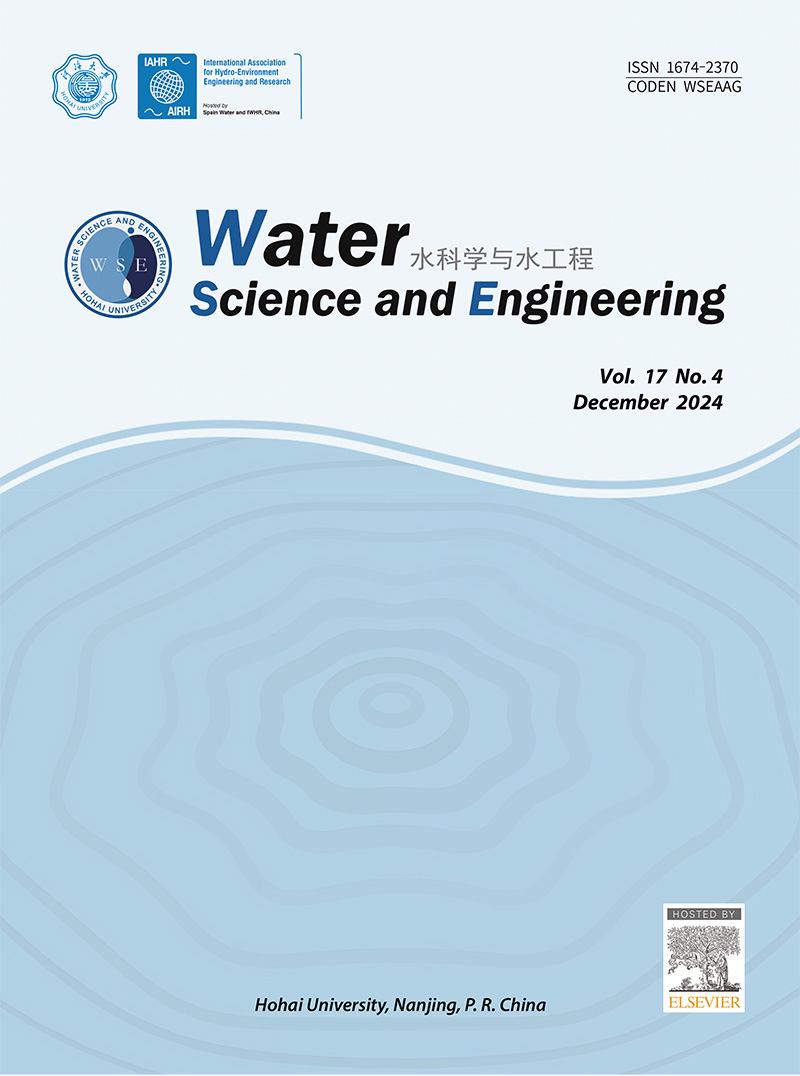明渠汇合处混合形态的三维数值模拟
IF 4.3
Q1 WATER RESOURCES
引用次数: 0
摘要
明渠汇合处是两条溪流或河流汇合处,在水利工程和河流动力学中起着至关重要的作用。这些汇合点具有复杂的水动力学特征,受合并水体流量比的影响。本文采用三维数值模拟方法对明渠汇合处的混合结构进行了研究。建立了一个全面的三维数值模型,并对从受控实验室实验中获得的数据集进行了验证。该数据集包含三维时间平均速度测量值。采用倾斜诱导和应力诱导方程组作为核心控制方程,为模拟各种场景提供了框架。总共分析了十个不同的病例。结果表明,流量比对湍流度、横向和垂直涡度以及混合分布的影响随着流量比的增大而增强。由速度梯度和涡度驱动的混合结构揭示了横向和垂直涡度对汇合处流体动力行为和混合分布的重要影响。具体来说,来流动量比决定了混合过程的空间演化。研究表明,混合分布是识别河道中冲刷形成的关键指标。向左岸诱导的高归一化速度导致了水面的超高,增加了河床物质的可能性,并在升高的水面下形成了显著的冲刷孔。这种新颖的方法提供了对汇合处混合模式的更深入的理解,特别是在流量比平衡但流量大小不同的情况下。本文章由计算机程序翻译,如有差异,请以英文原文为准。
Three-dimensional numerical simulation of mixing patterns at open channel confluences
Open channel confluences, where two streams or rivers converge, play a crucial role in hydraulic engineering and river dynamics. These confluences are characterized by complex hydrodynamics influenced by the discharge ratios of merging water bodies. This study investigated the mixing structure at open channel confluences using three-dimensional numerical modeling. A comprehensive three-dimensional numerical model was developed and validated against a dataset obtained from controlled laboratory experiments. This dataset incorporated three-dimensional time-averaged velocity measurements. The skew-induced and stress-induced equation systems were adopted as the core governing equations, providing a framework for simulating various scenarios. A total of ten different cases were analyzed. The results highlighted the effect of discharge ratios on turbulence, lateral and vertical vorticities, and the distribution of mixing, which intensified with higher magnitudes of discharge ratios. The mixing structure, driven by velocity gradients and vorticity, revealed the significant role of lateral and vertical vorticities in determining hydrodynamic behaviors and mixing distributions at confluences. Specifically, the momentum ratio of incoming flows governed the spatial evolution of mixing processes. This study revealed that the distribution of mixing served as a key indicator for identifying the formation of mid-channel scours. High normalized velocities induced toward the left bank led to the superelevation of the water surface, enhancing the potential for bed material and the formation of significant scour holes beneath the elevated water surface. This novel approach provides a deeper understanding of the mixing patterns at confluences, particularly in scenarios with equilibrated discharge ratios but in different magnitudes.
求助全文
通过发布文献求助,成功后即可免费获取论文全文。
去求助
来源期刊

Water science and engineering
WATER RESOURCES-
CiteScore
6.60
自引率
5.00%
发文量
573
审稿时长
50 weeks
期刊介绍:
Water Science and Engineering journal is an international, peer-reviewed research publication covering new concepts, theories, methods, and techniques related to water issues. The journal aims to publish research that helps advance the theoretical and practical understanding of water resources, aquatic environment, aquatic ecology, and water engineering, with emphases placed on the innovation and applicability of science and technology in large-scale hydropower project construction, large river and lake regulation, inter-basin water transfer, hydroelectric energy development, ecological restoration, the development of new materials, and sustainable utilization of water resources.
 求助内容:
求助内容: 应助结果提醒方式:
应助结果提醒方式:


